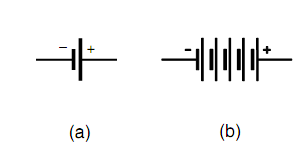Basic Symbols:
The easiest schematic symbol is the one symbolizing a wire or electrical conductor: a straight solid line. At times dashed lines are used to represent conductors, but generally, broken lines are drawn to separation diagrams into constituent circuits or to point out that certain components interact with each other or function in step with each other. The conductor lines are almost always drawn either horizontally or vertically up and down the page so that the imaginary charge carriers are forced to march in formation like soldiers. This remains the diagram neat and simple to read.
Whenever two conductor lines cross, they are not associated at the crossing point unless a heavy black dot is placed where the two lines meet. The dot always must be clearly visible wherever conductors are to be connected, no matter how many meet at the junction.
Resistor is indicated by a zigzag line. A variable resistor, like a rheostat or potentiometer, is indicated by a zigzag line with an arrow via it or by a zigzag line with an arrow pointing at it. These symbols are as shown below.

Figure: (a) A fixed resistor. (b) A two-terminal variable resistor. (c) A three-terminal potentiometer.
An electrochemical cell is shown by two parallel lines, one longer than other. The longer line symbolizes the positive terminal. The battery, or combination of cells in series, is indicated by an alternating series of parallel lines, long-short-long-short. The symbol for a cell and a battery are as shown in figure below.

Figure: (a) An electrochemical cell. (b) A battery.
SOME MORE SYMBOLS
Meters are represented as circles. At times the circle has an arrow inside it, and the meter type, like mA (milliammeter) or V (voltmeter), is written alongside the circle, as shown in figure below. Sometimes the meter type is represented inside the circle, and there is no arrow as shown in figure below. It doesn't matter which way it is completed as long as you are consistent everywhere in a given diagram.

Figure: Meter symbols: (a) designator outside; (b) designator inside.
Some other general symbols involve the lamp, the capacitor, the earth ground, the iron-core coil, the air-core coil, the chassis ground, the alternating current source, the set of terminals, and the black box (that can stand for almost anything), a rectangle with the designator written inside. These are shown in figure below.

Figure: More common schematic symbols:(a) incandescent lamp; (b) fixed-value capacitor; (c) air-core coil; (d) iron-core coil; (e) chassis ground; (f) earth ground; (g) ac source; (h) terminals; and (i) and black box.